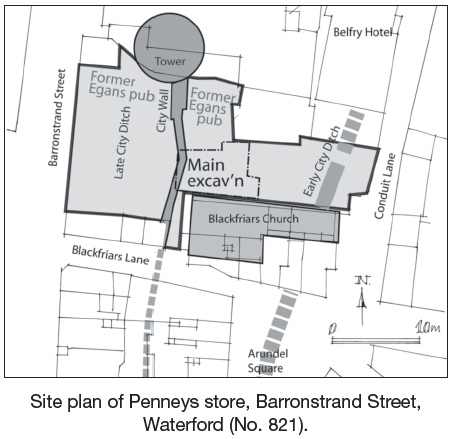2009:821 - WATERFORD: Penney's Store, Barronstrand Street, Waterford
County: Waterford
Site name: WATERFORD: Penney's Store, Barronstrand Street
Sites and Monuments Record No.: WA009–005
Licence number: E4013; C342
Author: Dave Pollock
Author/Organisation Address: Knockrower Road, Stradbally, Co. Waterford
Site type: Historic town
Period/Dating: Multi-period
ITM: E 660677m, N 612552m
Latitude, Longitude (decimal degrees): 52.261329, -7.111145
The site of Penneys store, Barronstrand Street, Waterford, is in the historic city of Waterford, and within the zone of archaeological potential. The site for the extended store was assessed in 2005 and found to include a length of medieval city wall standing two storeys high, late medieval graves associated with the Dominican friary and some remains of earlier medieval buildings (Excavations 2006, No. 2005, 05E1185).
The Dominican friary and the city wall are national monuments, and planning conditions included preserving the city wall in situ and investigating those parts of the development site where archaeological material might be disturbed. Ministerial consent was obtained to carry out archaeological investigations ahead of redevelopment, and to monitor groundworks.
Archaeological investigations commenced on the site of Egan’s pub in April, following the demolition of the building. The new ground-floor level for the store is considerably higher than the former floor level of the pub, and investigations were largely restricted to a platform of high ground towards the rear. Fragments of the medieval friary buildings, and contemporary and later burials, were investigated.
Due to a change of foundation design, part of this area was investigated through the clay platform (upcast from the city ditch) under the friary, on to early medieval building remains.
Along the north side of Egan’s, part of a large circular tower was rediscovered, recorded, and reburied. The tower is similar in plan (c. 15m diameter) to Reginald’s Tower and is probably Tergesius’ tower, built at the north-west corner of the medieval city.
Investigation of the sensitive central part of Penneys, where a double-lift well and escalator were proposed and late medieval burials and fragmentary early buildings were expected, commenced in May. Work here was interrupted to allow demolition of the building above. During the interruption, investigations were undertaken on the east side of the site, close to Conduit Lane, in advance of cutting for an ESB substation.
Work on the east side found the stumps of medieval walls from the east and north ranges, a late medieval chapel with infant burials and a medieval burial-ground built over an earlier city ditch, part of the Viking city defences.
The medieval city wall in the central part of the former Penneys store survived as a single course of stones in one area, and was absent from another. But here the line was marked by parallel rows of small holes, the casts of wooden piles driven into the ground by the medieval builders.
A wide platform of clay under the wall extended back into the friary grounds. Timbers from early friary buildings were set in pits cut into the clay, and stumps survived in the waterlogged conditions.
Below the clay platform a shallow soil overlay two to four generations of wattle buildings, part of a suburb outside the Viking city. In the opened area three houses had doors facing a road running downhill to the river. The houses had extensions to the rear, and freestanding buildings in backyards. Woodwork thrown flat in one yard appears to be dismantled furniture of parts of boats.
An area including the footprint of a new double-lift well, a new escalator (subsequently not installed) and adjacent pile caps and ground beams was investigated to subsoil.
The main excavations came to an end in early July, remaining groundworks were monitored and in September a small excavation was opened in the footprint of the late chapel by Conduit Lane, ahead of services being laid. All archaeological work has now come to an end on site.



